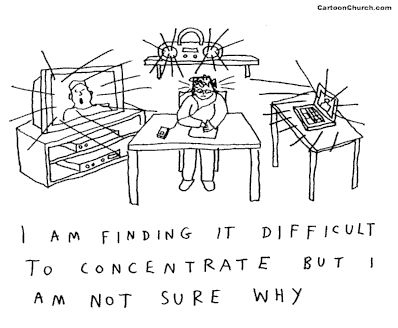Attention seems an odd addition to the dimensions of Emotional Style as described by Richard Davidson in The Emotional Life of Your Brain, since we usually think of attention as a cognitive ability. A closer look, however, reveals that attention has both emotional and cognitive elements. Sights and sounds that grab our attention are distracting enough in and of themselves, but when we layer in an emotional component, such as when shouting breaks out in a restaurant or we hear someone crying inconsolably, it can be very hard to keep our focus. The ability to calmly focus and resist distractions is an important aspect of Emotional Style.
Those of us at the Focused end of Attention can plug away regardless of being in the throes of emotional turmoil. A fight with our spouse is put to one side as we turn our attention to preparing for a client meeting. The dramatic accusations and door-slamming of our teenage daughter are parked for the moment, as we draw up the grocery list and pay the bills as usual.
At the Unfocused end, we are easily distracted. Emotional impulses continually interrupt the task at hand. The shiny bobble beckons enticingly as we flit from one topic to the next, shifting our attention from one stimulus to the next. At an extreme, we may be said to have Attention Deficit Hyperactivity Disorder (ADHD).
In Emotional Style, Attention is measured in two ways:
- Selective Attention involves the conscious decision to be immersed in stimuli, yet remain focused on one thing, such as tuning into our companion’s voice at a crowded cocktail party, while filtering out the other conversations around us. This capacity is a key component for other dimensions of Emotional Style as failure to selectively attend can make it very difficult to be Self-Aware or Tuned In. One way to think of this is as the “depth” of attention.
- Open, Non-Judgmental Awareness is the ability to take in signals from the external environment, but without getting so stuck on them that it impairs our ability to take in others signals. Think of having awareness of a pain in our knee, without getting highjacked by it. Those skilled in this type of attention tend to have a high sense of contentment and emotional balance. They’re unflappable, and not jostled by emotional ups and downs. This might be thought of as the “breadth” of attention.
- Related to Open-Non Judgmental Awareness is Attentional Blink, which occurs when one thing captures our attention such that we become briefly unaware of our environment. The “blink” is the time it takes our brain to “reset”. Your partner comes home from work and announces they’ve received a promotion, which will necessitate moving across the country. This captures your attention such that you fail to notice the pot boiling over on the stove, or the dog tracking mud across the floor. Well developed Open, Non-Judgmental Awareness serves to lessen the time lapse involved in Attentional Blink.
What’s happening in the brain? There are two related mechanisms. One involves the strength of the signal in the “on”, or attended, channel. The second one serves to inhibit the signals in the “off”, or ignored, channel. These mechanisms involve a circuit between two brain regions: The pre-frontal cortex (PFC), which is critical for maintaining attention and the parietal cortex, the brain’s steering wheel.
On the surface, it would seem that more attention is always better, yet it is possible to be too focused. Has anyone ever complained that the building could burn down and you wouldn’t notice? Ever got so zeroed in on one aspect of a project that you failed to notice something way more important? Can’t see the forest for the trees? This describes an excess of Selective Attention.
Being Unfocussed gets a lot more press, however. “Pay Attention!” How often have we heard it? The news is filled with example of failures of attention such accidents caused by texting while driving, and soaring rates of prescriptions for ADHD. In these instances the PFC is underactive and the attention is stimulus driven.
To Increase Focus
- Selective Attention:
- Mindfulness Meditation, followed by Focused-Attention or One-Point meditation
- Open, Non-Judgmental Awareness
- Meditation: Open Monitoring or Open Presence Meditation. These practices modulate brain waves to make them more receptive to outside stimulus
To decrease Focus
- this usually refers to weakening Selective Attention. Interesting, this is improved by increasing Open, Non-Judgmental Awareness
- reduce activity in your PFC, to open your mind to more input from the environment and move to a more receptive attentional stance
- Meditation: Open Monitoring or Open Presence Meditation. These practices modulate brain waves to make them more receptive to outside stimulus
Additional Resources
- Mindfulness Based Stress Reduction
- Insight Meditation Society in Barre, Mass.
- Spirit Rock Meditation Centre in Woodcare, CA
- Tergar in Minneapolis, MN

